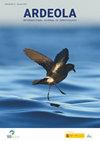法国阿尔卑斯和比利牛斯山岩雷鸟幼鸟的出生扩散和生存
IF 1.2
4区 生物学
Q2 ORNITHOLOGY
引用次数: 2
摘要
种群动力学研究的一个重要方面是了解从亲代独立到进入繁殖种群的出生分散和幼崽生存。分散允许邻近种群之间的遗传连通性和人口补偿。这些问题对于局限于山顶的物种来说尤为重要,比如南欧的岩雷鸟。我们通过无线电跟踪1999年9月在两个研究区域捕获的113只幼鸟,研究了1999年至2018年间法国阿尔卑斯山和比利牛斯山脉幼鸟的出生扩散和生存。在这两个地点,出生分散发生在两个离散的阶段,秋季(10 - 11月)和春季(3月下旬- 5月中旬)。秋季雌虫的分散距离是雄虫的2倍,春季雌虫的分散距离减小,但差异不显著。两性幼鱼在比利牛斯山脉比在阿尔卑斯山脉分布得更远(雄性:3.5比1.4公里;雌性:6.5对4.4公里),我们更多地将这种情况归因于两个种群之间的遗传差异,而不是环境因素。至于传播的地理障碍,我们的无线电跟踪数据和广泛的视觉观察表明,生活在阿尔卑斯山和比利牛斯山脉的石雷鸟很少飞越10-12公里宽的山谷。从性别和地点综合来看,10个月(9 - 6月)的成活率为0.636 (95%CI: 0.551 ~ 0.734)。在鸟类第一次繁殖期间(4 - 6月),长距离的分散往往会降低它们的存活率,这一结果表明了这种分散的延迟效应。-Novoa, C, Resseguier, J.,缪法-乔利,B., Blanch Casadesus, J., Arvin-Berod, M., Gracia Moya, J.和Desmet, J.(2021)。法国阿尔卑斯和比利牛斯山岩雷鸟幼鸟的出生扩散和生存。中国生物医学工程学报,28(6):1233 - 1241。本文章由计算机程序翻译,如有差异,请以英文原文为准。
Natal Dispersal and Survival of Juvenile Rock Ptarmigan Lagopus Muta in the French Alps and Pyrenees
Knowledge of natal dispersal and juvenile survival from parental independence until recruitment into breeding populations is an important aspect of population dynamics studies. Dispersal allows genetic connectivity and demographic compensation between neighbouring populations. These issues are particularly significant for species confined to mountaintops, as is the Rock Ptarmigan Lagopus muta in southern Europe. We studied natal dispersal and survival in juvenile Rock Ptarmigan in the French Alps and Pyrenees between 1999 and 2018 by radiotracking 113 young captured in September in two study areas. At both sites natal dispersal occurred in two discrete phases, in autumn (October-November) and in spring (late March-mid-May). Juvenile females dispersed twice as far as males in autumn at both sites but this difference decreased in spring and was not significant. Juveniles of both sexes dispersed further in the Pyrenees than in the Alps (males: 3.5 vs. 1.4km; females: 6.5 vs. 4.4km), a situation we attribute more to genetic differences between the two populations rather than to environmental factors. As to geographical barriers to dispersal, our radiotracking data along with extensive visual observations suggest that Rock Ptarmigan living in the Alps and the Pyrenees rarely fly across valleys 10-12km wide. For sexes and locations combined, the survival rate of juvenile Rock Ptarmigan during a ten-month period (September to June) was 0.636 (95%CI: 0.551-0.734). Long-distance dispersal tended to reduce the survival of birds during their first breeding attempt (April-June), a result that suggests a delayed effect of such dispersal.—Novoa, C., Resseguier, J., Muffat-Joly, B., Blanch Casadesus, J., Arvin-Berod, M., Gracia Moya, J. & Desmet, J.F. (2021). Natal dispersal and survival of juvenile Rock Ptarmigan Lagopus muta in the French Alps and Pyrenees. Ardeola, 68: 123-141.
求助全文
通过发布文献求助,成功后即可免费获取论文全文。
去求助
来源期刊
CiteScore
2.30
自引率
6.20%
发文量
16
审稿时长
>12 weeks
期刊介绍:
Ardeola: International Journal of Ornithology is the scientific journal of SEO/BirdLife, the Spanish Ornithological Society. The journal had a regional focus when it was first published, in 1954. Since then, and particular during the past two decades, the journal has expanded its thematic and geographical scope. It is now a fully international forum for research on all aspects of ornithology. We thus welcome studies within the fields of basic biology, ecology, behaviour, conservation and biogeography, especially those arising from hypothesis-based research. Although we have a long publication history of Mediterranean and Neotropical studies, we accept papers on investigations worldwide.
Each volume of Ardeola has two parts, published annually in January and July. The main body of each issue comprises full-length original articles (Papersand Review articles) and shorter notes on methodology or stimulating findings (Short Communications). The publication language is English, with summaries, figure legends and table captions also in Spanish. Ardeolaalso publishes critical Book Reviewsand PhD-Dissertation Summaries; summarising ornithological theses defended in Spain. Finally there are two Spanish-language sections, Ornithological News; summarising significant recent observations of birds in Spain, and Observations of Rare Birds in Spain, the annual reports of the Spanish Rarities Committee.

 求助内容:
求助内容: 应助结果提醒方式:
应助结果提醒方式:


